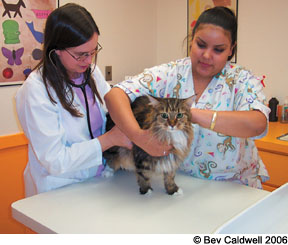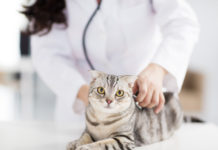My veterinarian recommends that I bring my cat, Snow, to her office every six months for a routine checkup, but this is the first time Ive heard this suggestion. Are twice-yearly exams really necessary? Snow absolutely HATES getting into the carrier and going to the veterinarian, but if you think its worth stressing her out, Ill do my best.
For a number of years, veterinarians have suggested that cats over the age of seven years be examined every six months. But this recommendation makes sense for cats of any age. And heres why: Cats tend to hide illness. This tendency serves them well in the wild, where they dont want to draw the attention of predators.But it doesnt serve them well when it keeps their owners from realizing that they need treatment. More times than I can count, a kitty showed up in my exam room with an illness that had only become obvious to the cats person when it became severe. If only wed been able to catch the disease earlier, the likelihood of a successful (and, perhaps, a less expensive) treatment would have been much greater, and we couldve spared the kitty weeks or months of feeling bad.
Recognizing subtle signs of sickness is also important
Twice-yearly wellness exams are only part of the story. Its equally important to watch your cat for subtle behavior changes that may be the first signs of sickness, and to notify your veterinarian immediately. A newly launched public information campaign of the American Association of Feline Practitioners (AAFP) with which Ive been actively involved – The Great Cat Watch for Wellness Sake (see http://www.catwellness.org/) – encourages twice-yearly examinations and emphasizes the importance of watching for the following ten behavioral changes that often signal an illness:

288
Inappropriate elimination behavior. A cat thats urinating or defecating outside the litter box may have an underlying illness. Medical problems like urinary tract disease, diabetes mellitus, arthritis and diseases of the intestinal tract should be ruled out before the condition is deemed to be a primary behavioral problem.
Changes in interaction. Is your cat interacting less (or more) with you or other family members, both animal and human? Less interaction is typical of many illnesses, whereas more interaction is often seen in older cats with hyperthyroidism. And a cat may become aggressive if its in pain (diseased teeth or sore, arthritic joints, as examples).
Changes in activity. Again, knowing whats normal for your cat is very important so that changes can be noted.
Changes in sleeping habits. Sixteen to 18 hours of sleep per day is typical for most healthy adult cats, but much of this time is spent catnapping. A catnapper should respond quickly to usual stimuli, such as your opening a can of cat food. A sleeping cat thats more difficult to arouse may be sick.
Changes in food and water consumption. Diabetes mellitus and hyperthyroidism are examples of conditions that can increase appetite; countless diseases can cause a decrease.
Unexplained weight loss or gain. Assess your cats body condition by feeling along the ribs. They should be easy to feel, but not prominent. If in doubt, schedule regular body condition checks and weigh-ins at the veterinarians office. And because obesity is, well, a growing problem (sorry) in cats, regular checks can catch small weight gains before they become a big problem.
Changes in grooming. A cats coat is usually clean, odor-free and free of mats. A decrease in grooming, heralded by a greasy or matted appearance, has many causes; an increase can result from undue stress or itchy skin disease.
Signs of stress. Changes in a cats environment can lead to signs of stress, including decreased grooming, less time spent sleeping, hiding, and changes in appetite. Ask your veterinarian about ways to help your cat adjust if you anticipate a change that might be stressful.
Changes in vocalization. Increased vocalization or howling is often seen with an underlying medical condition.
Bad breath. Up to 70 percent of cats have significant oral disease by the time they reach three years of age, and malodorous breath can be an early indicator. Twice-yearly oral examinations and professional attention, if necessary, can prevent painful and serious – and expensive – dental disease.
Making veterinary visits easier
Training a cat to accept, or even enjoy, being in a carrier and taking car trips is an important step in making it easier to visit your veterinarian. Tips on carrier training can be found in the November 2005 issue of CatWatch, and in the Feline Behavior Guidelines from the American Association of Feline Practitioners (http://www.aafponline.org/).



